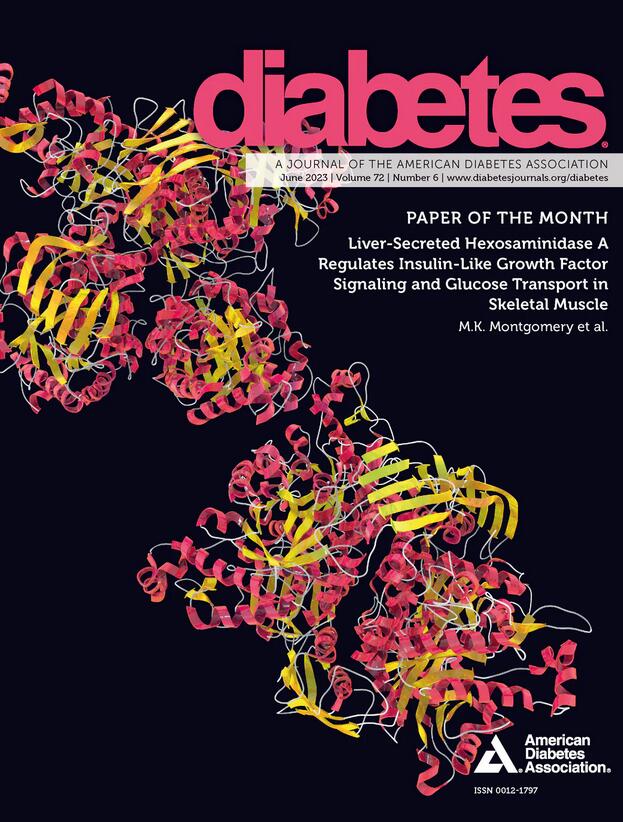1557-P:突变型羧基酯脂肪酶(CEL)驱动的 PAHSA 水解增加导致 MODY8 的ß细胞功能障碍
IF 6.2
1区 医学
Q1 ENDOCRINOLOGY & METABOLISM
引用次数: 0
摘要
成熟期发病的青年糖尿病 8 型(MODY8)是由 CEL 基因突变引起的,该基因主要在胰腺胰岛细胞中表达。MODY8 患者会出现胰腺外分泌和内分泌功能障碍。突变型(MUT)CEL 的酶功能如何导致 MODY8 型糖尿病的发生尚不清楚。棕榈酸羟基硬脂酸(Palmitic Acid Hydroxy Stearic Acids,PAHSAs)是一种信号脂质,可增强葡萄糖刺激的胰岛素分泌(GSIS)。CEL 是胰腺中主要的 PAHSA 水解酶。目的:确定 CEL 是否调节胰岛素分泌,以及 MUT CEL 的 PAHSA 水解活性增加是否导致 MODY8 发病。方法:我们在体外和体内的胰腺细胞中过表达野生型(WT)或 MUT CEL。在体内,我们使用了两种方法,一种是由针尖细胞特异性启动子驱动的 AAV8:在野生型小鼠的导管内注射 AAV,另一种是在 CEL KO 小鼠的腹腔内注射 AAV。CEL 的过表达只在尖突细胞中被检测到。结果9-PAHSA能增强人胰腺β细胞的GSIS。重组 CEL 可抑制 PAHSA 效应。与 WT CEL 相比,MUT CEL 在胰腺细胞中的过表达会增加 9-PAHSA 的水解活性。在体内,野生型小鼠胰腺细胞中 MUT CEL 的表达会明显影响葡萄糖耐量。在 CEL KO 小鼠中,MUT CEL 在胰腺细胞中的表达会损害 GSIS。在 CEL KO 小鼠中,WT 和 MUT CEL 都会降低胰腺 PAHSA 的总水平。然而,只有在表达 MUT CEL 的情况下,12/13-PAHSAs 才会减少。结论1)胰腺细胞中的 CEL 会改变 PAHSA 的水解并调节胰岛素分泌。2)MUT CEL 通过增加 PAHSA 的水解,从而限制正常 PAHSA 诱导的 GSIS 的增加,可能会导致糖尿病的发生。3)这些数据强调了尖塔-β细胞相互作用的关键作用以及 PAHSA 在胰岛素分泌中的生理作用,并为制定治疗 MODY8 和其他形式糖尿病的策略提供了机会。披露 A. Santoro:无。S. Kahraman:雇员;勃林格殷格翰公司。G. Basile:无:无。K. El Jellas:无。J. Hu:无。R. Tarpey:无。B.B. Johansson:无。E. Dirice:无。I. Syed:无。D. Siegel:无。A. Molven:无。B.B. Kahn:顾问团;Janssen Pharmaceuticals, Inc.顾问;Vida Ventures Advisors、Arrowhead Pharmaceuticals, Inc.R. Kulkarni:顾问团;诺和诺德、Biomea Fusion, Inc.顾问;Inversago Pharma.顾问团;REDD 制药公司。资金来源:K01 DK128075(Anna Santoro)、U01DK135095(Rohit N. Kulkarni)、R01DK067536(Rohit N. Kulkarni)、NIH R01 DK106210(Barbara B. Kahn)、JPB 基金会(Barbara B. Kahn)和 NIH P30 DK135043(Barbara B. Kahn)。Anna Santoro、Sevim Kahraman、Barbara B. Kahn 和 Rohit N. Kulkarni 的贡献相同。本文章由计算机程序翻译,如有差异,请以英文原文为准。
1557-P: Increased PAHSA Hydrolysis Driven by Mutant Carboxyl Ester Lipase (CEL) Contributes to Beta-Cell Dysfunction in MODY8
Maturity onset diabetes of the young type 8 (MODY8) is caused by genetic mutations in the CEL gene which is expressed primarily in pancreatic acinar cells. MODY8 patients develop pancreatic exocrine and endocrine dysfunction. How the enzymatic function of mutant (MUT) CEL contributes to the development of diabetes in MODY8 is unknown. Palmitic Acid Hydroxy Stearic Acids (PAHSAs) are signaling lipids that augment glucose-stimulated insulin secretion (GSIS). CEL is the major PAHSA hydrolytic enzyme in the pancreas. Aim: To determine whether CEL regulates insulin secretion and whether the increased PAHSA hydrolytic activity of MUT CEL contributes to MODY8 pathogenesis. Methods: We overexpressed wildtype (WT) or MUT CEL in acinar cells in vitro and in vivo. In vivo, we used 2 approaches both with AAV8 driven by an acinar cell specific promoter: intraductal AAV injections in wildtype mice and intraperitoneal AAV injections in CEL KO mice. CEL overexpression was detected exclusively in acinar cells. Results: 9-PAHSA augments GSIS in human pancreatic beta cells. Recombinant CEL inhibits the PAHSA effect. MUT CEL overexpression in acinar cells increases 9-PAHSA hydrolytic activity compared to WT CEL. In vivo, MUT CEL expression in acinar cells of wildtype mice markedly impairs glucose tolerance. In CEL KO mice, expression of MUT CEL in acinar cells impairs GSIS. Both WT and MUT CEL reduce total pancreatic PAHSA levels in CEL KO mice. However, 12/13-PAHSAs were reduced only with MUT CEL expression. Conclusions: 1) CEL in acinar cells alters PAHSA hydrolysis and modulates insulin secretion. 2) MUT CEL potentially contributes to the development of diabetes by increasing PAHSA hydrolysis and thereby limiting the normal PAHSA-induced augmentation of GSIS. 3) These data highlight the critical role of acinar-beta cell interactions and the physiologic role of PAHSAs in insulin secretion and provide opportunities for developing strategies to treat MODY8 and other forms of diabetes. Disclosure A. Santoro: None. S. Kahraman: Employee; Boehringer-Ingelheim. G. Basile: None. K. El Jellas: None. J. Hu: None. R. Tarpey: None. B.B. Johansson: None. E. Dirice: None. I. Syed: None. D. Siegel: None. A. Molven: None. B.B. Kahn: Advisory Panel; Janssen Pharmaceuticals, Inc. Consultant; Vida Ventures Advisors, Arrowhead Pharmaceuticals, Inc. R. Kulkarni: Advisory Panel; Novo Nordisk, Biomea Fusion, Inc. Consultant; Inversago Pharma. Advisory Panel; REDD Pharmaceutical. Funding K01 DK128075 (Anna Santoro), U01DK135095 (Rohit N. Kulkarni), R01DK067536 (Rohit N. Kulkarni), NIH R01 DK106210 (Barbara B. Kahn), JPB foundation (Barbara B. Kahn), and NIH P30 DK135043 (Barbara B. Kahn). Anna Santoro, Sevim Kahraman, Barbara B. Kahn and Rohit N. Kulkarni contributed equally.
求助全文
通过发布文献求助,成功后即可免费获取论文全文。
去求助
来源期刊

Diabetes
医学-内分泌学与代谢
CiteScore
12.50
自引率
2.60%
发文量
1968
审稿时长
1 months
期刊介绍:
Diabetes is a scientific journal that publishes original research exploring the physiological and pathophysiological aspects of diabetes mellitus. We encourage submissions of manuscripts pertaining to laboratory, animal, or human research, covering a wide range of topics. Our primary focus is on investigative reports investigating various aspects such as the development and progression of diabetes, along with its associated complications. We also welcome studies delving into normal and pathological pancreatic islet function and intermediary metabolism, as well as exploring the mechanisms of drug and hormone action from a pharmacological perspective. Additionally, we encourage submissions that delve into the biochemical and molecular aspects of both normal and abnormal biological processes.
However, it is important to note that we do not publish studies relating to diabetes education or the application of accepted therapeutic and diagnostic approaches to patients with diabetes mellitus. Our aim is to provide a platform for research that contributes to advancing our understanding of the underlying mechanisms and processes of diabetes.
 求助内容:
求助内容: 应助结果提醒方式:
应助结果提醒方式:


